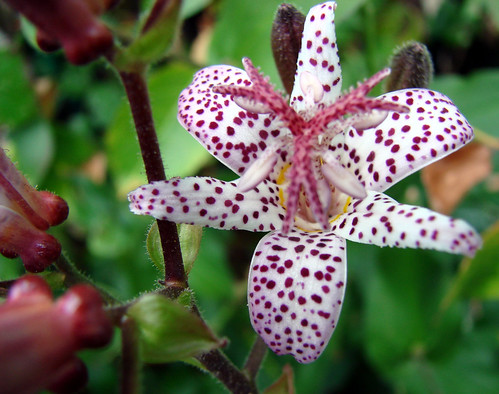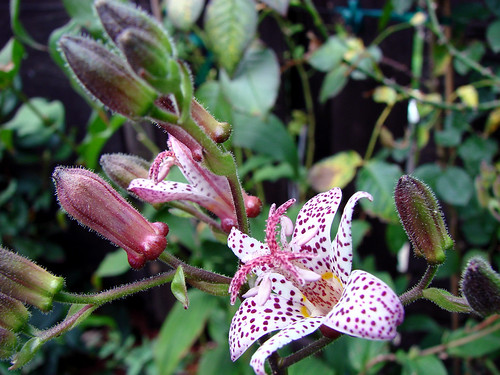
Join
Introducing – The Toad Lily –
Isn’t it a beautiful flower? It’s 1 to 1.5 inches in diameter.
Here’s another view that displays the bloom as well as it’s very phallic looking flower buds:
Toad lily, Tricyrtis hirta, is one of a dozen species of Asian herbs of the lily family that are found in the Himalayas, China and Japan.
This species grows 2-3 feet tall with gracefully arching stems arising from an underground root system. It has 4-inch long clasping leaves that are covered with a coat of fine hairs, hence the species name, which means “hairy.”
A variegated form is available with each leaf delicately edged with an eighth-inch halo of yellow.
The genus name Tricyrtis is from Latin and translates as “three convexities.” It refers to the three match-head sized swollen nectary glands at the base of each flower. The flowers are borne singly along the stem, where each of the alternate leaves attaches to the stem.
Established toad lilies may have as many as two dozen of these 2-inch wide flowers splayed out along the stem when they come into bloom in Mid-September to early October.
Individual toad lily blooms have six petals that are splattered with brownish purple blobs on a white background, giving an overall lavender effect. It’s from these spots that some English gardener made the connection with toads and burdened the lovely plant with its unfortunate moniker.
Above the petals, the anthers extend outward and surround the three-branched stigma, giving the sexual part of the flower the look of the octopus ride at the county fair, but of course somewhat smaller. If pollination occurs early enough before frost, an erect capsule will form.
Tricyrtis seems to be one of those plants that got misplaced in the plant shuffle of the 20th century but seems to have been recently rediscovered. While Bailey and other garden writers described it almost 100 years ago, nobody seemed to carry it until recent years. About 1990, Wayside gardens began featuring the plant, and today it’s fairly common in garden centers and nurseries. Dan Heims, a West Coast propagator, lists almost 40 cultivars of the various species.
Toad lilies must be grown in the shade. They are excellent companion plants to hostas and other inhabitants of deep shade. Fertile, well drained, uniformly moist organic soils are most to their liking, but they will tolerate lesser soils so long as they don’t contain too much clay. Extended droughts will cause tip and marginal leaf burning. While the foliage will die with the first hard freeze, they are perfectly winter hardy to at least US Zone 5a. New plants can be had by springtime division or by terminal cuttings taken in the spring from new growth. Slugs occasionally mar the beauty of the foliage but are not usually serious.
All parts of this plant are poisonous if ingested. 24 – 36″ in height, with lovely green foliage throughout the growing season. My Toad lilies were first planted about 4 years ago. The original planting was perhaps 1 to 2 feet in diameter, but it has now spread out and takes up a 3 foot long by 2 foot wide space.
Gardeners, Plant and Nature lovers can join in every Sunday, visit As the Garden Grows for more information.


I hope that you enjoyed learning about the Toad Lily. Have a great Sunday.
Don’t forget to Visit Tricia’s Musings I’ve got a post about my boulevard garden there today.
I’ m sorry I don’t have reading time, but the photos say it all I’m sure, they are superb! Fantastic shots! Really well done.
Wow! what a fun Lily that one is. I love it!
Your pictures and excellent information all the time REALLY makes me miss my own garden
But I’m glad that I can enjoy your instead!
Those are great! What an unusual flower!
Very nice! I love small blooms that pack such a large punch. This is a nice plant but not suitable for my garden if it is that poisoneous! Too many animals and small kids! But it sure is pretty!
Wow…. I may need to try and ind one of those… I have never seen one before. I have the perfect spot for it too.
I believe I have a sister to that plant in my interior garden. The plant itself has had a life outdoors as a summer plant in my garden last year and indoors through last winter to now.
The one I have is called a lipstick plant. It has those thick deep green leaves that are small and pointy, yet remind me of orchid leaves. The Lipstick plant is the same colour when the foils are closed…that deep majenta of the outside of the petal. then when it opens it is a solid pink inside instead of your lovely speckle.
I grow goldfish plants and the lipstick plants together in my interior garden bassinette.
mine is up
Very interesting. Lillies are my second favorite to roses. I’ve heard of this plant before, but found your description very informative. I would have never known it to be poisonous. It’s also good to know what type of companion plant for it to go with. A very exotic and gorgeous plant.Great shots.
Tricia — i did not realize you were posting a GTS on 2 different sites. I’ve been missing the posts here. Sorry. You have some great info here.
Also – i wonder can someone let Christine (are we there yet…) know that some of us cannot leave her comments unless she changes her defaults to allow non-blogger accounts access). I could not find an email address on her site otherwise i’d just send her a note.
Its Click and comment Monday.
have a Blessed Week
Those are so positively beautiful!